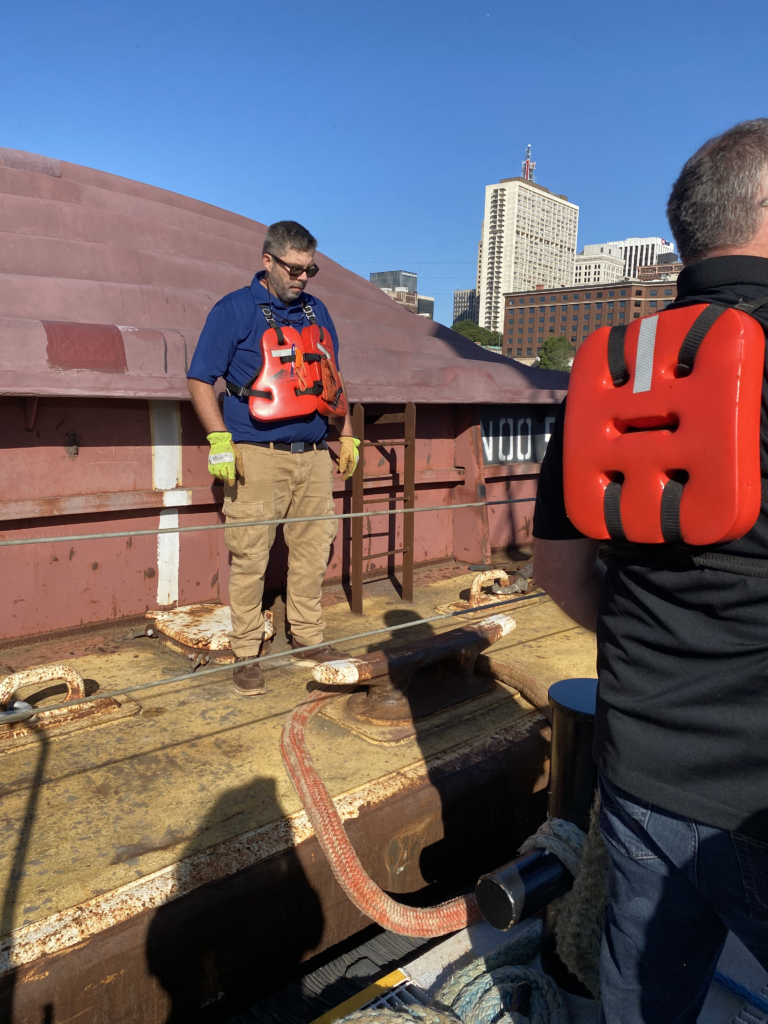$4.1 Million Flows from the Federal Government to the Port of Saint Paul

The Saint Paul Port Authority will receive a $4.14 million grant from the Maritime Administration’s Port Infrastructure Development Program. Funds will be used to fully rehabilitate a dockwall located at Barge Terminal Two (BT2). The 1,316-foot dockwall, built 1964, is need of significant repair and its failure poses a risk to all who ship commodities through Saint Paul. The Port Authority was one of 25 recipients nationwide to receive a portion of the $241 million grant pool available in 2021.
BT2 is located on the Mississippi River, just south of Downtown Saint Paul, underneath the Lafayette Bridge. Upper River Services (URS) leases the space from the Port Authority and serves as the harbor operator. In this role, URS relies on a fully functioning dockwall for barge towing, fleeting, cleaning, and repair services. URS has also assisted Ramsey County on multiple occasions with search and rescue efforts on the Mississippi River.
Increasing Safety, Enhancing Efficiencies, and Protecting the Environment
In the 1960s, barge sizes were inconsistent, and this is reflected in the original dockwall design. 50 years later, sizes have standardized, and the existing wall no longer aligns with modern-day barges. This could pose a safety risk to the men and women who work in the Saint Paul Harbor, including deckhands and barge cleaners employed by URS. Upgrades will mitigate this risk and enhance the health and safety of those whose jobs require them to move in between barges and land.
In addition, the BT2 project will mitigate the risk of a dockwall failure and the adverse economic impact that could follow. To be cost-effective and efficient, in a typical navigation season, river shipping in Minnesota relies on a two-way cargo haul process. Barges deliver much needed commodities upstream, where they are quickly unloaded and then cleaned and inspected by URS. From there, URS ensures they are promptly reloaded and sent back downstream carrying exports headed for national and international markets (primarily agriculture products including corn, soybeans, and wheat). Disruptions could cut exports by as much as 50 percent and increase shipping costs by 37 percent, impairing Minnesota farmers’ ability to be competitive in the global market.
And, while some commodities could be absorbed by the current rail transportation system, both costs and fuel emissions would rise. In fact, it takes approximately 216 rail cars to move the same amount of product as a typical 15-barge tow, carrying approximately 1,500 tons/barge.
Environmental Design
The Saint Paul Port Authority is committed to supporting sustainable development and minimizing the carbon footprint for all its projects. Key design elements to address climate change and environmental justice with the BT2 project include infrastructure electrification, energy efficiency, improved disaster preparedness and resiliency, energy and location-efficient construction, and reduced water use and disposal.
Project Funding and Timeline
The BT2 project is estimated to cost $12.17 million. The $4.14 million grant will be paired with a $6.3 million grant previously secured from the Minnesota Department of Transportation and a $1.73 million contribution from Port Authority river shipping funds. The Port Authority plans to release a Design RFP in January with the goal of completing the project in 2022.
Saint Paul Port Authority & River Shipping FAQs
- The Port Authority is an eligible inland port with the experience and authority to carry out the BT2 project
- Approximately 5.9 million tons of cargo pass through the Saint Paul Harbor each year; 4.1 million tons through Port Authority terminals and 1.8 million tons through privately owned terminals (source: United States Army Corp of Engineer’s Water Commerce Statistics Center)
- The fluctuating cost of barge shipping from Saint Paul to New Orleans averages approximately $25/ton
- Top import commodities include fertilizer, water treatment materials, steel, aggregate, cement, and road salt
- Top export commodities include corn, soybeans, potash, and steel to be recycled
About the Saint Paul Port Authority
The Minnesota Legislature established the Saint Paul Port Authority as a non-profit governmental agency in 1929 to manage the St. Paul Harbor. From 1932-1964, the Port Authority established four river shipping terminals, including BT2. All four river shipping terminals continue to be managed by the Port Authority, stimulating the local economy through good paying jobs and property tax revenue. In 1955, the Legislature authorized the Port Authority to engage in economic development activities inland.